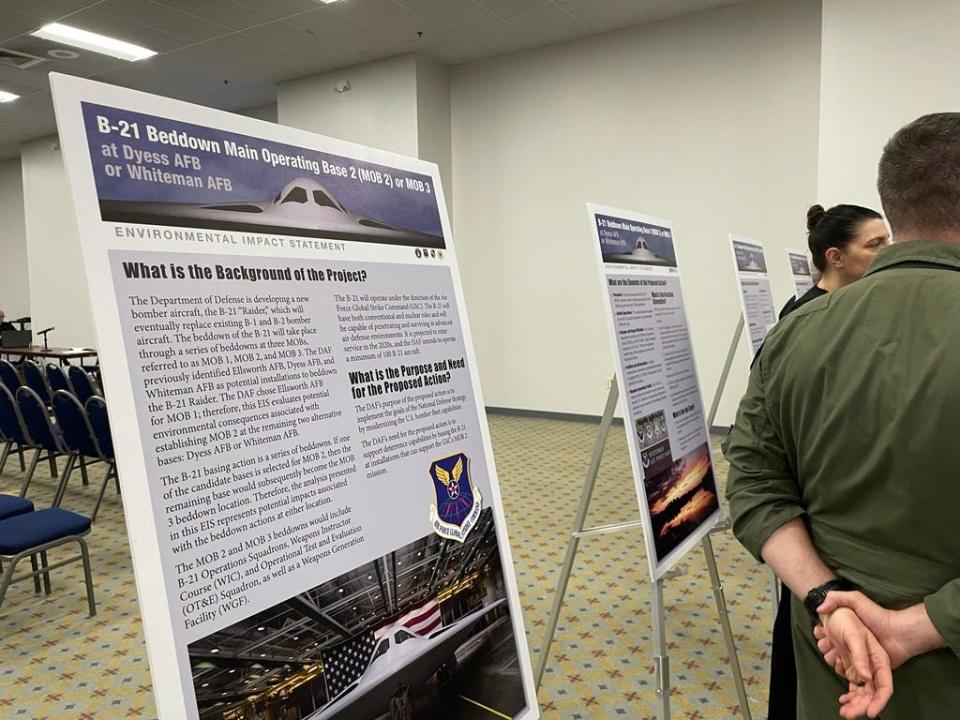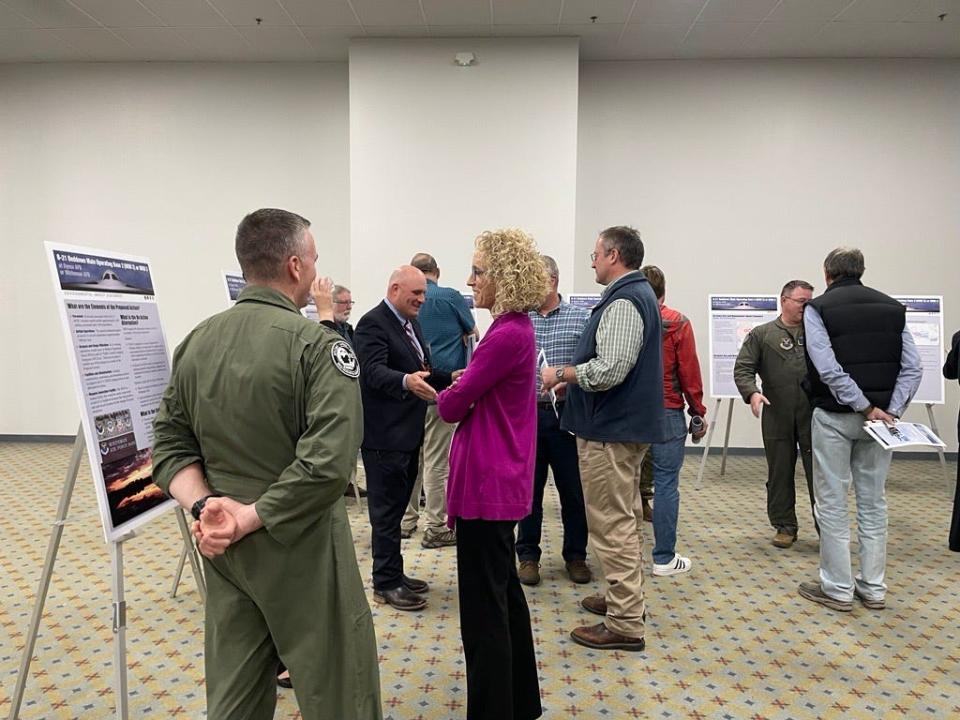Department of Defense looking to make Dyess AFB operational for new bomber aircraft
Dyess Air Force Base has and continues to be a critical part of the city of Abilene. Since its establishment in 1942 as Tye Army Air Field, the base has provided space for flight training and crucial support in airlift aid missions and combative weaponry defense for the United States.
In 2019, the Air Force named Dyess Air Force Base as a potential beddown for the new bomber aircraft that will be going into production.
B-21 “Raider”
In recent years, the Department of the Air Force has developed a new bomber aircraft, the B-21 “Raider,” which will eventually replace the existing B-1 and B-2 aircrafts.
The new B-21 will implement the goals of the National Defense Strategy by modernizing the U.S. bomber fleet. According to the U.S. Air Force mission for the new aircraft it will be used as “a dual-capable penetrating strike stealth bomber capable of delivering both conventional and nuclear munitions” which will support deterrence capabilities.

Action has been made in a series of installations to beddown Main Operating Bases (MOBs) for the B-21. In 2021, the Air Force named Ellsworth Air Force Base in South Dakota as MOB 1 which will serve as the main B-21 operating base and location of the Formal Training Unit.
Findings from Dyess AFB Environmental Impact Statement
As part of the initial research at Ellsworth AFB, Dyess Air Force Base and Whiteman Air Force Base in Missouri were listed as alternative locations.
With alternatives in mind Environmental Impact Statements (EIS) were conducted to study and evaluate environmental resources surrounding the Whiteman and Dyess bases. The purpose of the EIS is to present an analysis of environmental consequences of the proposed B-21 to the community under compliance with the National Environmental Policy Act.
The environmental resources studied in the EIS include air quality, airspace use and management, cultural resources, environmental justice, hazardous materials and solid wastes, physical resources like water and soil, socioeconomics and noise.
During the Draft EIS period, the public can review and make comments about the proposed project. A requirement of an EIS is to provide a “No Action Alternative” to ensure environmental protection if unforeseen issues arise. If the “No Action Alternative” is selected, the Department of Defense will search for other locations to implement the B-21 program as it is a major initiative in ensuring the U.S. nuclear triad remains effective.

The EIS analyzed the impacts on resources by comparing the current conditions of the base as used presently to the forecasted analysis after B-1 and B-2 aircrafts are retired and all B-21 aircraft have beddown.
The beddown of the B-21 would decrease the congestion in the airspace and annual operations. An estimated 4.2% or 2,000 fewer airfield operations would occur at Dyess AFB compared to the no action alternative. Operations are forecast to reduced between 7.6% and 66.5% across all proposed airspace units.
With the decrease in airspace operations, residents can anticipate a decrease in noise impacts in and around Dyess AFB. As for physical resources like water and soil, construction and B-21 usage will show no significant impact. There is low potential for soil erosion and, in areas containing floodplains management, rules will be followed to prevent damage to hydrologic properties.
The studies on air quality in and around Dyess AFB show no adverse impacts to regional air quality. However, air emissions would increase for all criteria pollutants and only PM10 would exceed indicator thresholds. PM10 are coarse particles, caused by dusty road and construction sites, that can irritate the eyes, nose and throat. To address the temporary construction-related emissions, implementation of construction Best Management Practices is included in the planning process.
According to the EIS, there are no adverse impacts to cultural resources anticipated from construction. Consultation results with State Historic Preservation Officers will be presented in the Final EIS.
As for hazardous materials and solid waste, management of substances and wastes will be accomplished in accordance with all regulatory requirements and established procedures.

Changes to Dyess AFB
If the B-21 program beddowns at Dyess AFB, Abilene will see an increase in base personnel and construction activities and a decrease in airfield operations.
Though Dyess airmen associated with the B-1 mission will depart from the base, an increase of 1,300 individuals will be brought in with the B-21 mission.
In the Dyess AFB general plan for construction for facilities and infrastructure, an estimated 4.2 million square feet will be under construction, 600,000 square feet will be under renovation and 300,000 square feet will be under demolition.
The proposed MOB 2 beddown will include construction of a Weapons Generation Facility which creates a 50-acre construction footprint and a 20-acre final compound. The facility will provide a safe and secure location for the storage of nuclear munitions.
Abilene citizens speak out on B-21 beddown at Dyess AFB
As part of the Draft EIS, public scoping meetings are presented to summarize the proposed action and explain environmental consequences. The public can make formal comments regarding the Draft EIS which will assist the Air Force in making an informed decision when deciding whether Dyess AFB or Whiteman AFB will be MOB 2.

At the Abilene meeting Dec. 5, seven speakers made public comments about the beddown of the B-21 at Dyess AFB.
Representatives from the Abilene Military Affairs Committee, AEP Texas, Atmos Energy and City of Abilene’s Transportation Services Department spoke in support of the B-21 beddown at Dyess AFB.
“The assets in our region support the mission, and the specific steps we've taken to prepare for the B-21 beddown. These include our water supply, wastewater management, millitary spousal employment, education, healthcare, gas and electric supply and our geographic advantages,” Greg Blair, chairmen of Abilene Military Affairs Committee, said. “Our community support is second to none and we stand ready enthusiastically and fully equipped to support the B-21 beddown.”
Mayor of Abilene Weldon Hurt provided comments on the natural resources that have served the Abilene community and Dyess AFB since the 1950s. He spoke on the existing city infrastructure to accommodate the influx of new airmen and their families and the support from the Abilene community to the mission of the Air Force and Dyess AFB.
“I believe an area of major corporations and small businesses thrive thanks to large talent pool, robust infrastructure and pro-business environment. Our economy is growing and vibrant,” Hurt stated.
Randy Williams, county commissioner for precinct 1 which consists of Dyess AFB, provided comment on the work done with property owners surrounding the base and their support of Dyess and the B-21 project. He mentioned a recent experience talking to a citizen whose property lays under a flight pattern.
“When you're trying to talk to them and a B-1 goes over, you realize you just stopped talking. I look at him and I say you didn't know you're building a house in the flight pattern, and the response without a doubt always is ‘it's the sweet sound of freedom,’” Williams said. “We are Dyess Air Force Base, and Dyess Air Force Base is us.”
Learn more and make a public comment
After the public review period closes in January, the final decision of which base will house MOB 2 and MOB 3 will be announced in fall of 2024.
Individuals seeking more information can visit the public website at www.B21EIS.com.
The public comment period will remain open until January 5, 2024. Comments can be submitted verbally at a public scoping meeting, digitally through the B-21 EIS website and by mail. All comments sent through mail must be postmarked by Jan. 5, 2024.
Any inquiries can be directed to Dyess AFB Public Affairs at (325) 696-4820.
This article originally appeared on Abilene Reporter-News: Dyess AFB considered for new bomber aircraft mission

